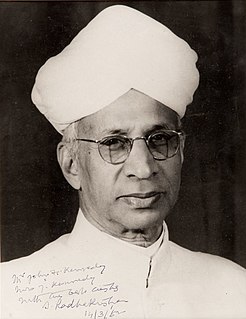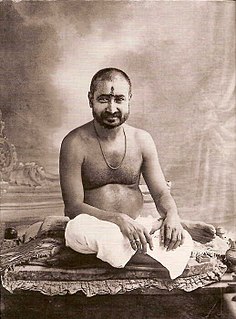 W
WSwami Abhedananda, born Kaliprasad Chandra was a direct disciple of the 19th century mystic Ramakrishna Paramahansa and the founder of Ramakrishna Vedanta Math. Swami Vivekananda sent him to the West to head the Vedanta Society of New York in 1897, and spread the message of Vedanta, a theme on which he authored several books through his life, and subsequently founded the Ramakrishna Vedanta Math, in Calcutta and Darjeeling.
 W
WAdbhutananda, born Rakhturam, was a direct monastic disciple of Ramakrishna, a mystic of nineteenth century Bengal. He is familiarly known as Latu Maharaj among the followers of Ramakrishna. Adbhutananda was the first monastic disciple to come to Ramakrishna. While most of Ramakrishna's direct disciples came from the Bengali intelligentsia, Adbhutananda's lack of formal education made him unique amongst them. He was a servant boy of a devotee of Ramakrishna, and he later became his monastic disciple. Though unlettered, Adbhutananda was considered as a monk with great spiritual insight by Ramakrishna's followers, and Vivekananda regarded him as "the greatest miracle of Ramakrishna".
 W
WAdvaita Bodha Deepika, Lamp of Non-Dual Knowledge, is an Advaita Vedanta text written by Sri Karapatra Swami.
 W
WAdvaita Vedānta is a school of Hindu philosophy, and is a classic system of spiritual realization in Indian tradition. The term Advaita refers to the idea that Brahman alone is ultimately real, the phenomenal transient world is an illusory appearance (maya) of Brahman, and the true self, atman, is not different from Brahman.
 W
WDāsbodh, loosely meaning "advice to the disciple" in Marathi, is a 17th-century bhakti (devotion) and jnana (insight) spiritual text. It was orally narrated by the saint Samarth Ramdas to his disciple, Kalyan Swami. The Dāsbodh provides readers with spiritual guidance on matters such as devotion and acquiring knowledge. Besides this, it also helps in answering queries related to day-to-day life and how to find solutions to it.
 W
WThe Inchagiri Sampradaya, also known as Nimbargi Sampradaya, is a lineage of Hindu Navnath c.q. Lingayat teachers from Maharashtra which was started by Shri Bhausaheb Maharaj. It is inspired by Deshastha Brahmin Sant Mat teachers as Dnyaneshwar, Eknath and Samarth Ramdas. The Inchagiri Sampradaya has become well-known throughout the western world due to the popularity of Sri Nisargadatta Maharaj.
 W
WKashmir Shaivism, or Trika Shaivism, is nondualist tradition of Shaiva-Shakta Tantra which originated sometime after 850 CE. Though this tradition was very influential in Kashmir and is thus often called Kashmir Shaivism, it was actually a pan-Indian movement termed "Trika" by its great exegete, Abhinavagupta, which also flourished in Orissa and Maharashtra. Defining features of the Trika tradition are its idealistic and monistic Pratyabhijna ("Recognition") philosophical system, propounded by Utpaladeva and Abhinavagupta, and the centrality of the three goddesses Parā, Parāparā, and Aparā.
 W
WNisargadatta Maharaj, born Maruti Shivrampant Kambli, was a Hindu guru of nondualism, belonging to the Inchagiri Sampradaya, a lineage of teachers from the Navnath Sampradaya and Lingayat Shaivism.
 W
WRamana Maharshi was an Indian Hindu sage and jivanmukta. He was born Venkataraman Iyer, but is mostly known by the name Bhagavan Sri Ramana Maharshi.
 W
WThe Mokṣopāya or Mokṣopāyaśāstra is a Sanskrit philosophical text on salvation for non-ascetics, written on the Pradyumna hill in Śrīnagar in the 10th century AD. It has the form of a public sermon and claims human authorship and contains about 30,000 śloka's. The main part of the text forms a dialogue between Vasiṣṭha and Rāma, interchanged with numerous short stories and anecdotes to illustrate the content. This text was later expanded and vedanticized, which resulted in the Yogavāsiṣṭha.
 W
WNeo-Advaita, also called the Satsang-movement and Nondualism, is a New Religious Movement, emphasizing the direct recognition of the non-existence of the "I" or "ego," without the need of preparatory practice. Its teachings are derived from, but not authorised by, the teachings of the 20th century sage Ramana Maharshi, as interpreted and popularized by H. W. L. Poonja and several of his western students.
 W
WNeo-Vedanta, also called Hindu modernism, neo-Hinduism, Global Hinduism and Hindu Universalism, are terms to characterize interpretations of Hinduism that developed in the 19th century. The term "Neo-Vedanta" was coined by German Indologist Paul Hacker, in a pejorative way, to distinguish modern developments from "traditional" Advaita Vedanta.
 W
WIn spirituality, nondualism, also called non-duality, means "not two" or "one undivided without a second". Nondualism primarily refers to a mature state of consciousness, in which the dichotomy of I-other is "transcended", and awareness is described as "centerless" and "without dichotomies". Although this state of consciousness may seem to appear spontaneous, it usually follows prolonged preparation through ascetic or meditative/contemplative practice, which may include ethical injunctions. While the term "nondualism" is derived from Advaita Vedanta, descriptions of nondual consciousness can be found within Hinduism, Buddhism, Sufism and western Christian and neo-Platonic traditions.
 W
WSarvepalli Radhakrishnan pronunciation (help·info) was an Indian philosopher, academic, and statesman who served as the first Vice President of India (1952–1962) and the second President of India (1962–1967).
 W
WSahaja means spontaneous enlightenment in Indian and Tibetan Buddhist spirituality. Sahaja practices first arose in Bengal during the 8th century among Buddhist yogis called Sahajiya siddhas.
 W
WSelf-enquiry, also spelled self-inquiry, is the constant attention to the inner awareness of "I" or "I am" recommended by Ramana Maharshi as the most efficient and direct way of discovering the unreality of the "I"-thought.
 W
WShuddadvaita is the "purely non-dual" philosophy propounded by Vallabhacharya, the founding philosopher and guru of the Vallabha sampradāya or Puṣṭimārga, a Hindu Vaishnava tradition focused on the worship of Krishna. Vallabhacharya's pure form (nondualist) philosophy is different from Advaita. The Shrinathji temple at Nathdwara, and compositions of eight poets, including Sur, are central to the worship by the followers of the sect.
 W
WSri Siddharameshwar Maharaj (1888–1936) was a guru in the Inchagiri Sampradaya founded by his guru Shri Bhausaheb Maharaj, a branch of the Navnath Sampradaya, the 'Nine Masters' tradition in India. He was the Guru of Nath teachers Sri Nisargadatta Maharaj, Sri Ranjit Maharaj, Sri Kadsiddheshwar Maharaj, Sri Ganpatrao Maharaj, Kannur and Sri Vilasananad Maharaj, Keni.
 W
WYoga Vasistha is a philosophical text attributed to Valmiki, although the real author is Vasishta. The complete text contains over 29,000 verses. The short version of the text is called Laghu Yogavasistha and contains 6,000 verses. The text is structured as a discourse of sage Vasistha to Prince Rama. The text consists of six books. The first book presents Rama's frustration with the nature of life, human suffering and disdain for the world. The second describes, through the character of Rama, the desire for liberation and the nature of those who seek such liberation. The third and fourth books assert that liberation comes through a spiritual life, one that requires self-effort, and present cosmology and metaphysical theories of existence embedded in stories. These two books are known for emphasizing free will and human creative power. The fifth book discusses meditation and its powers in liberating the individual, while the last book describes the state of an enlightened and blissful Rama.